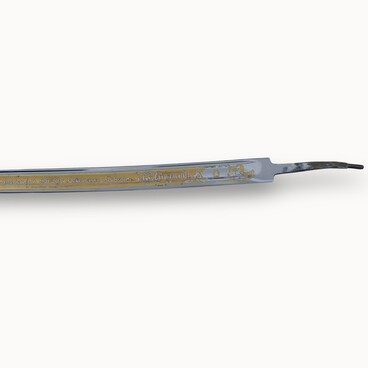One of the largest collections of the Zlatoust City Museum of Local Lore is called “Documents”. Among its most distinctive exhibits is the business card of the inventor and designer of automatic weapons Fyodor Vasilyevich Tokarev.
The front side of the business card depicts two Orders of Lenin, the Order of the Red Star and the Hammer and Sickle medal, as well as the inscription “Hero of Socialist Labor, Deputy of the Supreme Soviet of the USSR Fyodor Vasilyevich Tokarev, Doctor of Technical Sciences, winner of Stalin Prize, inventor and designer of automatic weapons.”
The back of the business card features a hand-written autograph in ink: “For Zoya Fyodorovna Tiunova as a keepsake. Thank you for the medical care.” The designer lived and worked in Zlatoust during the Great Patriotic War and gave this business card to his doctor at hospital 1128, where he was treated.
Fyodor Vasilyevich Tokarev was born into a Cossack family in the Don region in 1871. He became an armorer and served in the Don Cossack Host. During the First World War, he was a sotnia commander at the front and was awarded six military orders. He proved to be a talented gunsmith.
Later he was transferred to the Sestroretsk Arms Factory. It was there that the testing of the world’s first automatic rifle, designed by Tokarev, began. Afterward, the inventor worked at the Tula Arms Factory. He also participated in the modernization of the Maxim machine gun, then created an aircraft machine gun that was adopted by the Workers’ and Peasants’ Red Army.
Fyodor Tokarev’s most famous inventions were the TT pistol (commonly known as the Tokarev), as well as the SVT-40 self-loading rifle and the AVT-40 automatic rifle. They were used by Soviet troops during the Great Patriotic War.
The inventor was awarded four Orders of Lenin, two Orders of the Red Banner of Labor, the Order of Suvorov, 2nd Class, the Order of the Patriotic War, 1st Class, and the Order of the Red Star. In 1941, Tokarev’s design bureau was evacuated to Zlatoust, where he lived and continued to work throughout the war.
One of Zlatoust weapons factories produced his SVT-40 rifle. After the war, the experience gained from operating Tokarev’s self-loading rifles helped to develop hand-held automatic weapons, which were very simple and low-maintenance.
The front side of the business card depicts two Orders of Lenin, the Order of the Red Star and the Hammer and Sickle medal, as well as the inscription “Hero of Socialist Labor, Deputy of the Supreme Soviet of the USSR Fyodor Vasilyevich Tokarev, Doctor of Technical Sciences, winner of Stalin Prize, inventor and designer of automatic weapons.”
The back of the business card features a hand-written autograph in ink: “For Zoya Fyodorovna Tiunova as a keepsake. Thank you for the medical care.” The designer lived and worked in Zlatoust during the Great Patriotic War and gave this business card to his doctor at hospital 1128, where he was treated.
Fyodor Vasilyevich Tokarev was born into a Cossack family in the Don region in 1871. He became an armorer and served in the Don Cossack Host. During the First World War, he was a sotnia commander at the front and was awarded six military orders. He proved to be a talented gunsmith.
Later he was transferred to the Sestroretsk Arms Factory. It was there that the testing of the world’s first automatic rifle, designed by Tokarev, began. Afterward, the inventor worked at the Tula Arms Factory. He also participated in the modernization of the Maxim machine gun, then created an aircraft machine gun that was adopted by the Workers’ and Peasants’ Red Army.
Fyodor Tokarev’s most famous inventions were the TT pistol (commonly known as the Tokarev), as well as the SVT-40 self-loading rifle and the AVT-40 automatic rifle. They were used by Soviet troops during the Great Patriotic War.
The inventor was awarded four Orders of Lenin, two Orders of the Red Banner of Labor, the Order of Suvorov, 2nd Class, the Order of the Patriotic War, 1st Class, and the Order of the Red Star. In 1941, Tokarev’s design bureau was evacuated to Zlatoust, where he lived and continued to work throughout the war.
One of Zlatoust weapons factories produced his SVT-40 rifle. After the war, the experience gained from operating Tokarev’s self-loading rifles helped to develop hand-held automatic weapons, which were very simple and low-maintenance.



